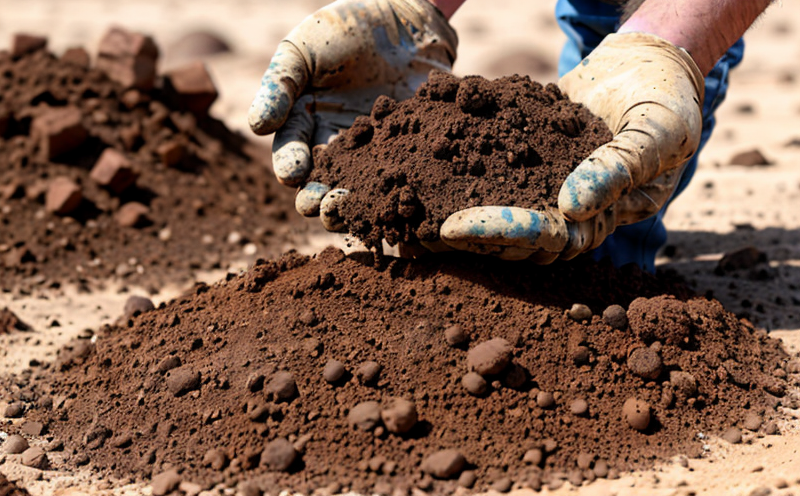ASTM D4318 Atterberg Limits of Soils Testing
The ASTM D4318 Atterberg Limits of Soils Testing is a fundamental procedure used to determine the water content at which soils transition from solid, liquid, and plastic states. This test is crucial for understanding soil behavior in various environmental conditions, particularly during construction projects, geotechnical assessments, and mining operations. The process involves measuring the moisture content of the soil sample at three critical points: Liquid Limit (LL), Plastic Limit (PL), and Shrinkage Limit (SL). These limits are essential for characterizing the plasticity and liquidity index of soils, which in turn informs decisions regarding excavation, foundation design, and material selection.
The Atterberg Limits test is widely used across multiple sectors including mining testing. In mines, accurate knowledge about soil properties helps engineers predict how ground will behave under stress or moisture changes, ensuring safety and stability of infrastructure projects. For instance, knowing the exact point at which a soil transitions from plastic to solid can prevent costly accidents by allowing operators to manage water content more precisely.
The procedure itself is simple yet precise; it requires careful preparation and execution. A representative sample of soil is taken, air-dried, and ground to a uniform particle size before being placed in thin layers within a container lined with wax paper. The moisture content is then gradually increased using distilled water while mixing the soil until the desired consistency is reached for each limit.
The Liquid Limit (LL) is determined by adding small amounts of water to the soil sample until it becomes smooth and can be rolled into a cylinder 3 mm in diameter without breaking. The height of this cylinder, known as the "pendulum value," indicates whether further moisture addition is necessary.
The Plastic Limit (PL), on the other hand, requires rolling out thin sheets of moistened soil until they can no longer be rolled without breaking. This point marks the transition from plastic to solid state and provides insight into a soil's cohesive strength.
The Shrinkage Limit (SL) is defined as the lowest moisture content at which any further reduction in volume occurs when drying takes place. Understanding this limit helps engineers assess potential settlement issues during excavation or construction activities.
In summary, the ASTM D4318 Atterberg Limits test offers valuable insights into soil characteristics that are critical for effective project planning and execution across diverse industries such as mining where reliable data on material properties ensures safe operations.
Why It Matters
The importance of accurate Atterberg Limit testing cannot be overstated, especially within the context of mining activities. Properly characterizing soil types and their limits is essential for several reasons:
Precise Excavation Planning: Knowing the exact moisture content at which a particular type of soil will behave helps engineers plan excavation more accurately, reducing risks associated with unexpected ground conditions.
Safety Assurance: By understanding the liquid and plastic states of soils, mining companies can better predict potential hazards like landslides or unstable structures, thereby enhancing overall safety standards.
Fuel Efficiency: Optimizing the moisture content ensures that haul roads remain stable even under heavy loads, minimizing fuel consumption by reducing wheel slippage.
Cost Savings: Accurate characterization allows for efficient use of resources, avoiding unnecessary expenditures on excessive water or drying costs.
In addition to these practical benefits, compliance with international standards like ASTM D4318 ensures that all stakeholders involved in mining projects adhere to industry best practices. This not only upholds the integrity of operations but also contributes positively towards environmental sustainability goals.
Benefits
Informed Decision Making: By providing detailed information about soil behavior, this test enables better decision-making processes in terms of material selection and construction methods.
Risk Mitigation: Understanding the exact limits helps minimize risks related to ground stability during mining activities. This leads to safer working environments for personnel involved in these operations.
Sustainability: Accurate characterization supports sustainable practices by ensuring that resources are used efficiently without unnecessary waste.
Regulatory Compliance: Adherence to established standards like ASTM D4318 ensures compliance with local regulations, thus avoiding potential legal issues and fines.
The results obtained from the Atterberg Limits test play a pivotal role in ensuring that all aspects of mining operations are conducted efficiently and effectively. From initial site assessments to ongoing monitoring during construction phases, this information is indispensable for maintaining high standards across every stage of project development.
Quality and Reliability Assurance
Precision in Measurement: The precision required by ASTM D4318 ensures that measurements are accurate to within 0.5% moisture content, which is crucial for reliable results.
Standard Operating Procedures (SOPs): Compliance with standardized procedures guarantees consistent testing outcomes across different laboratories and locations.
Replicate Samples: Using multiple replicates ensures that variations in individual samples do not skew final results, enhancing the reliability of findings.
Data Transparency: Providing detailed reports enhances transparency, allowing all parties involved to review and validate test outcomes easily.
The commitment to quality and reliability is further bolstered by regular calibration of equipment against national standards. This ensures that all instruments used in the testing process remain accurate over time. Additionally, training sessions for personnel involved in conducting these tests ensure they possess up-to-date knowledge about best practices and advancements within the field.





